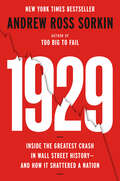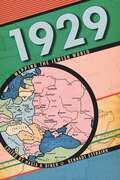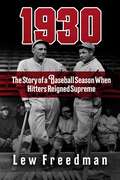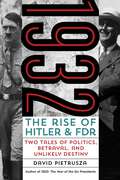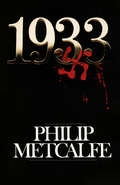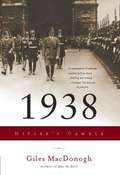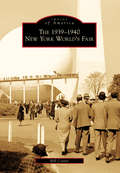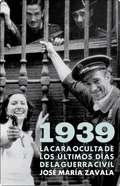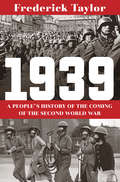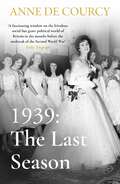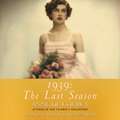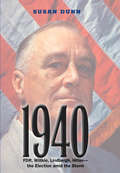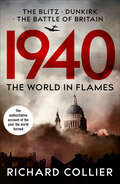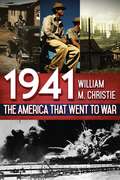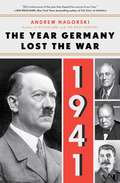- Table View
- List View
1929: Inside the Greatest Crash in Wall Street History--and How It Shattered a Nation
by Andrew Ross Sorkin&“It is one of the best narrative histories I&’ve read.&”—The Wall Street JournalNamed a Most Anticipated Book by New York Times Books Review, TIME, Washington Post, Associated Press, Town & Country, New York Post, and moreFrom the bestselling author of Too Big to Fail, &“the definitive history of the 2008 banking crisis,&” (The Atlantic) comes a riveting narrative of the most infamous stock market crash in history—one with ripple effects that still shape our society today.In 1929, the world watched in shock as the unstoppable Wall Street bull market went into a freefall, wiping out fortunes and igniting a depression that would reshape a generation. But behind the flashing ticker tapes and panicked traders, another drama unfolded—one of visionaries and fraudsters, titans and dreamers, euphoria and ruin.With unparalleled access to historical records and newly uncovered documents, New York Times bestselling author Andrew Ross Sorkin takes readers inside the chaos of the crash, behind the scenes of a raging battle between Wall Street and Washington and the larger-than-life characters whose ambition and naivete in an endless boom led to disaster. The dizzying highs and brutal lows of this era eerily mirror today&’s world—where markets soar, political tensions mount, and the fight over financial influence plays out once again.This is not just a story about money. 1929 is a tale of power, psychology, and the seductive illusion that this time is different. It&’s about disregarded alarm bells, financiers who fell from grace, and skeptics who saw the crash coming—only to be dismissed until it was too late.Hailed as a landmark book, Too Big to Fail reimagined how financial crises are told. Now, with 1929, Sorkin delivers an immersive, electrifying account of the most pivotal market collapse of all time—with lessons that remain as urgent as ever. More than just a history, 1929 is a crucial blueprint for understanding the cycles of speculation, the forces that drive financial upheaval, and the warning signs we ignore at our peril.
1929: Mapping the Jewish World (Alternative Criminology #13)
by Gennady Estraikh Hasia R DinerWinner of the 2013 National Jewish Book Award, Anthologies and CollectionsThe year 1929 represents a major turning point in interwar Jewish society, proving to be a year when Jews, regardless of where they lived, saw themselves affected by developments that took place around the world, as the crises endured by other Jews became part of the transnational Jewish consciousness. In the United States, the stock market crash brought lasting economic, social, and ideological changes to the Jewish community and limited its ability to support humanitarian and nationalist projects in other countries. In Palestine, the anti-Jewish riots in Hebron and other towns underscored the vulnerability of the Zionist enterprise and ignited heated discussions among various Jewish political groups about the wisdom of establishing a Jewish state on its historical site. At the same time, in the Soviet Union, the consolidation of power in the hands of Stalin created a much more dogmatic climate in the international Communist movement, including its Jewish branches. Featuring a sparkling array of scholars of Jewish history, 1929 surveys the Jewish world in one year offering clear examples of the transnational connections which linked Jews to each other—from politics, diplomacy, and philanthropy to literature, culture, and the fate of Yiddish—regardless of where they lived. Taken together, the essays in 1929 argue that, whether American, Soviet, German, Polish, or Palestinian, Jews throughout the world lived in a global context.
1930: The Story of a Baseball Season When Hitters Reigned Supreme
by Lew FreedmanThe 1930 Major League baseball season was both marvelous and horrendous, great for hitters, embarrassing for pitchers. In totality it was just this side of insane as an outlier among all seasons.Major League Baseball began with the founding of the National League in 1876. In the 145 seasons since then, one season stands out as unique for the astounding nature of hitting: 1930.A flipside of 1968&’s &“Year of the Pitcher,&” when the great St. Louis Cardinals Bob Gibson compiled a 1.12 earned run average and Detroit Tigers Denny McLain won 31 games, the 1930 season was when the batters reigned supreme. During this incredible season, more than one hundred players batted .300, the entire National League averaged .300, ten players hit 30 or more home runs, and some of the greatest individual performances established all-time records. From New York Giants Bill Terry&’s .401 average—the last National Leaguer to hit over .400—to the NL-record 56 home runs and major league–record 192 runs batted in by Chicago Cubs Hack Wilson, the 1930 season is a wild, sometimes unbelievable, often wacky baseball story.Breaking down the anomaly of the season and how each team fared, veteran journalist Lew Freeman tells the story of a one-off year unlike any other. While the greats stayed great, and though some pitchers did hold their own—with seven winning 20 or more games, including 28 by Philadelphia Athletics&’ Lefty Grove and 25 by Cleveland Indians&’ Wes Ferrell—Freedman shares anecdotes about those players that excelled in 1930, and only 1930. More than ninety years later, 1930 offers insight into a season that still stands the test of time for batting excellence.
1931 Desh ya Prem?: १९३१ देश या प्रेम?
by Satya Vyas1931 देश या प्रेम एक रोमांचक ऐतिहासिक पुस्तक है जो 20वीं सदी के शुरुआती भारतीय स्वतंत्रता आंदोलन के दौरान घटित घटनाओं पर आधारित है। यह सत्य व्यास द्वारा लिखित कृति क्रांतिकारी नेताओं के जीवन, भावनाओं, और समाज पर उनके प्रभाव को दर्शाती है, जिसमें गांधीजी का नमक सत्याग्रह और भगत सिंह व उनके साथियों की शहादत के घटनाक्रम शामिल हैं। पुस्तक क्रांति के मानवीय पहलू को उजागर करती है, नायकों की मानसिक, सामाजिक और पारिवारिक परिस्थितियों पर ध्यान केंद्रित करती है, और भारतीय इतिहास तथा स्वतंत्रता आंदोलन के कम ज्ञात किस्सों में रुचि रखने वाले किसी भी व्यक्ति के लिए एक अनिवार्य पठन है।
1932: FDR, Hoover, and the Dawn of a New America
by Scott MartelleA fascinating behind-the-scenes look at a year in American history that still resonates today, 1932: FDR, Hoover, and the Dawn of a New America tells the story of a battered nation fighting for its own future amid the depths of the Great Depression. At the start of 1932, the nation&’s worst economic crisis has left one-in-four workers without a job, countless families facing eviction, banks shutting down as desperate depositors withdraw their savings, and growing social and political unrest from urban centers to the traditionally conservative rural heart of the country. Amid this turmoil, a political decision looms that will determine the course of the nation. It is a choice between two men with very diferent visions of America: Incumbent Republican Herbert Hoover with his dogmatic embrace of small government and a largely unfettered free market, and New York&’s Democratic Governor Franklin Delano Roosevelt and his belief that the path out of the economic crisis requires government intervention in the economy and a national sense of shared purpose. Now veteran journalist Scott Martelle provides a gripping narrative retelling of that vitally significant year as social and political systems struggled under the weight of the devastating Dust Bowl, economic woes, rising political protests, and growing demand for the repeal of Prohibition. That November, voters overwhelmingly rejected decades of Republican rule and backed Roosevelt and his promise to redefine the role of the federal government while putting the needs of the people ahead of the wishes of the wealthy. Deftly told, this illuminating work spotlights parallel events from that pivotal year and brings to life figures who made headlines in their time but have been largly forgotten today. Ultimately, it is the story of a nation that, with the help of a leader determined to unite and inspire, took giant steps toward a new America.
1932: The Rise of Hitler and FDR--Two Tales of Politics, Betrayal, and Unlikely Destiny
by David PietruszaTwo Depression-battered nations confronted destiny in 1932, going to the polls in their own way to anoint new leaders, to rescue their people from starvation and hopelessness. America would elect a Congress and a president ebullient aristocrat Franklin Roosevelt or tarnished Wonder Boy Herbert Hoover. Decadent, divided Weimar Germany faced two rounds of bloody Reichstag elections and two presidential contests doddering reactionary Paul von Hindenburg against rising radical hate-monger Adolf Hitler. The outcome seemed foreordained unstoppable forces advancing upon crumbled, disoriented societies. A merciless Great Depression brought greater perhaps hopeful, perhaps deadly transformation: FDR s New Deal and Hitler s Third Reich. But neither outcome was inevitable. Readers enter the fray through David Pietrusza s page-turning account: Roosevelt s fellow Democrats may yet halt him at a deadlocked convention. 1928 s Democratic nominee, Al Smith, harbors a grudge against his one-time protege. Press baron William Randolph Hearst lays his own plans to block Roosevelt s ascent to the White House. FDR s politically-inspired juggling of a New York City scandal threatens his juggernaut. In Germany, the Nazis surge at the polls but twice fall short of Reichstag majorities. Hitler, tasting power after a lifetime of failure and obscurity, falls to Hindenburg for the presidency also twice within the year. Cabals and counter-cabals plot. Secrets of love and suicide haunt Hitler. Yet guile and ambition may yet still prevail. 1932 s breathtaking narrative covers two epic stories that possess haunting parallels to today s crisis-filled vortex. It is an all-too-human tale of scapegoats and panaceas, class warfare and racial politics, of a seemingly bottomless depression, of massive unemployment and hardship, of unprecedented public works/infrastructure programs, of business stimulus programs and damaging allegations of political cronyism, of waves of bank failures and of mortgages foreclosed, of Washington bonus marches and Berlin street fights, of once-solid financial empires collapsing seemingly overnight, of rapidly shifting social mores, and of mountains of irresponsible international debt threatening to crash not just mere nations but the entire global economy. It is the tale of spell-binding leaders versus bland businessmen and out-of-touch upper-class elites and of two nations inching to safety but lurching toward disaster. It is 1932 s nightmare with lessons for today. "
1932: The Rise of Hitler and FDR--Two Tales of Politics, Betrayal, and Unlikely Destiny
by David PietruszaTwo Depression-battered nations confronted destiny in 1932, going to the polls in their own way to anoint new leaders, to rescue their people from starvation and hopelessness. America would elect a Congress and a president—ebullient aristocrat Franklin Roosevelt or tarnished &“Wonder Boy&” Herbert Hoover. Decadent, divided Weimar Germany faced two rounds of bloody Reichstag elections and two presidential contests—doddering reactionary Paul von Hindenburg against rising radical hate-monger Adolf Hitler.The outcome seemed foreordained—unstoppable forces advancing upon crumbled, disoriented societies. A merciless Great Depression brought greater—perhaps hopeful, perhaps deadly—transformation: FDR&’s New Deal and Hitler&’s Third Reich.But neither outcome was inevitable.Readers enter the fray through David Pietrusza&’s page-turning account: Roosevelt&’s fellow Democrats may yet halt him at a deadlocked convention. 1928&’s Democratic nominee, Al Smith, harbors a grudge against his one-time protege. Press baron William Randolph Hearst lays his own plans to block Roosevelt&’s ascent to the White House. FDR&’s politically-inspired juggling of a New York City scandal threatens his juggernaut. In Germany, the Nazis surge at the polls but twice fall short of Reichstag majorities. Hitler, tasting power after a lifetime of failure and obscurity, falls to Hindenburg for the presidency—also twice within the year. Cabals and counter-cabals plot. Secrets of love and suicide haunt Hitler.Yet guile and ambition may yet still prevail.1932&’s breathtaking narrative covers two epic stories that possess haunting parallels to today&’s crisis-filled vortex. It is an all-too-human tale of scapegoats and panaceas, class warfare and racial politics, of a seemingly bottomless depression, of massive unemployment and hardship, of unprecedented public works/infrastructure programs, of business stimulus programs and damaging allegations of political cronyism, of waves of bank failures and of mortgages foreclosed, of Washington bonus marches and Berlin street fights, of once-solid financial empires collapsing seemingly overnight, of rapidly shifting social mores, and of mountains of irresponsible international debt threatening to crash not just mere nations but the entire global economy.It is the tale of spell-binding leaders versus bland businessmen and out-of-touch upper-class elites and of two nations inching to safety but lurching toward disaster. It is 1932&’s nightmare—with lessons for today.
1933
by Philip Metcalfe"Using letters, diaries, and memoirs, Metcalfe distills the personalities, viewpoints, and day-to-day reactions of five alert and often directly involved witnesses to Hitler's consolidation of power. They are: U.S. Ambassador to Germany, William Dodd, and his high-spirited daughter, Martha; Bella Fromm, a glamorous German society columnist who was Jewish and made no secret of it; Ernest Hanfstaengl, Hitler's somewhat buffoonish foreign-press chief; and Rudolf Diels, the first head of the Gestapo." --Publishers Weekly
1936 ... On the Continent
by Eugene FodorThis guide takes you on a prewar journey through 30 European countries, including the British Isle.
1938: Hitler's Gamble
by Giles MacDonoghIn this masterly new work, acclaimed historian Giles MacDonogh explores the moment when Hitler gambled everything. Until 1938, Hitler could be dismissed as a ruthless but efficient dictator, a problem to Germany alone; after 1938 he was clearly a threat to the entire world.In that year The Third Reich came of age and the Führer showed his hand - bringing Germany into line with Nazi ideology and revealing long-held plans to take back those parts of Europe lost to 'Greater Germany' after the First World War. The sequence of events began in January with the purging of the army, and escalated with the merger with Austria - the Anschluss, and the first persecutions of Viennese Jewry.In the following months Hitler moulded the nation to his will. Elections brought him a 99 per cent approval rating. MacDonogh gives a full account of the nationalist opposition that failed to topple Hitler in September 1938. By the end of the year the brutal reality of the Nazi regime was revealed by Joseph Goebbels in Kristallnacht, a nationwide assault on Germany's native Jewish population.MacDonogh's access to many new sources gives insights into what life was like under the eye of the regime, revealing the role of the Anglican Church after the Anschluss, saving those Jews who were willing to convert, and also the Kendrick Affair - the still-secret details of the Austrian double agent who brought down the whole MI6 operation in Austria and Germany, just as the Chamberlain government began negotiations with Hitler at Munich. A remarkable and revealing account of Hitler's opening moves to war.
1938: Hitler's Gamble
by Giles MacdonoghIn this masterful narrative, acclaimed historian Giles MacDonogh chronicles Adolf Hitler's consolidation of power over the course of one year. Until 1938, Hitler could be dismissed as a ruthless but efficient dictator, a problem to Germany alone; after 1938 he was clearly a threat to the entire world. It was in 1938 that Third Reich came of age. The Führer brought Germany into line with Nazi ideology and revealed his plans to take back those parts of Europe lost to "Greater Germany" after the First World War. From the purging of the army in January through the Anschluss in March, from the Munich Conference in September to the ravages of Kristallnacht in November, MacDonogh offers a gripping account of the year Adolf Hitler came into his own and set the world inexorably on track to a cataclysmic war.
1939
by Richard OveryThe world burst into war in a blast of bombs and tanks when the Nazis marched into Poland. Blitzkriegmoves from the aftermath of World War I into the dramatic events of 1938-41. Rare items of memorabilia-including Hitler’s order to invade Poland and Montgomery’s diary charting the evacuation from Dunkirk-bring the era and events to life as never before. The CD features Chamberlain’s announcement of war; Churchill’s "finest hour” speech; and Hitler’s first speech from the newly German Danzig.
1939-1940 New York World's Fair, The
by Bill CotterAfter enduring 10 harrowing years of the Great Depression, visitors to the 1939-1940 New York World's Fair found welcome relief in the fair's optimistic presentation of the "World of Tomorrow." Pavilions from America's largest corporations and dozens of countries were spread across a 1,216-acre site, showcasing the latest industrial marvels and predictions for the future intermingled with cultural displays from around the world. Well known for its theme structures, the Trylon and Perisphere, the fair was an intriguing mixture of technology, science, architecture, showmanship, and politics. Proclaimed by many as the most memorable world's fair ever held, it predicted wonderful times were ahead for the world even as the clouds of war were gathering. Through vintage photographs, most never published before, The 1939-1940 New York World's Fair recaptures those days when the eyes of the world were on New York and on the future.
1939. La cara oculta de los últimos días de la Guerra Civil
by José María ZavalaJosé María Zavala examina los episodios más sorprendentes y desconocidos de los cien últimos días de la Guerra Civil. Y lo hace alejándose del recorrido histórico tradicional para zambullirse en los pactos secretos entre los dos bandos, en las escenas cotidianas más inexploradas, en los momentos más sorprendentes. A través de capítulos que pueden leerse como historias independientes, el autor desvela la cara oculta de unos meses que cambiaron la historia de España para siempre. El libro combina el enfoque en los personajes clave con el interés por destapar las luces y las sombras de la vida de la gente corriente en aquellas semanas decisivas. De los entresijos del golpe de Estado del coronel Casado a los testimonios sobre el hambre en la retaguardia, de los planes secretos para desatar una guerra bacteriológica al papel que desempeñaron los Kennedy en el conflicto, Zavala estudia lo que nadie sabe sobre figuras tan conocidas como Azaña, Negrín o Carrillo y saca a la luz el papel que tuvieron en la guerra estrellas de cine como Errol Flynn, adivinos pintorescos como el profesor Aris, que predijo el inicio de la revuelta militar, o soldados anónimos como Feliciano Martín Villoria. Estos y otros muchos sucesos arrojan luz sobre las numerosas lagunas que, todavía hoy, siguen existiendo sobre la memoria histórica.«Un libro que trata de los aspectos menos conocidos de la Guerra Civil, escrito con la agilidad y el enfoque certero característicos de Zavala, y que el lector podrá disfrutar con placer y soltura.»STANLEY G. PAYNE
1939: A People's History Of The Coming Of The Second World War
by Frederick TaylorA best-selling historian’s chronicle of the dramatic months from the Munich Agreement to Hitler’s invasion of Poland and the beginning of World War II. In the autumn of 1938, Europe believed in the promise of peace. But only a year later, the fateful decisions of just a few men had again led Europe to a massive world war. Drawing on contemporary diaries, memoirs, and newspapers, as well as recorded interviews, 1939 is a narrative account of what the coming of the Second World War felt like to those who lived through it. Frederick Taylor, author of renowned histories of the Berlin Wall and the bombing of Dresden, highlights the day-to-day experiences of ordinary citizens as well as those who were at the height of power in Germany and Britain. Their voices lend an intimate flavor to this often-surprising account of the period and reveal a marked disconnect between government and people, for few people in either country wanted war. 1939 is a vivid and richly peopled narrative of Europe’s slide into the horrors of war and a powerful warning for our own time.
1939: The Last Season
by Anne de CourcyA wonderful portrait of British upper-class life in the Season of 1939 - the last before the Second World War.The Season of 1939 brought all those 'in Society' to London. The young debutante daughters of the upper classes were presented to the King and Queen to mark their acceptance into the new adult world of their parents. They sparkled their way through a succession of balls and parties and sporting events.The Season brought together influential people not only from Society but also from Government at the various events of the social calendar. Prime Minister Neville Chamberlain chaperoned his debutante niece to weekend house parties; Lord Halifax, the Foreign Secretary, lunched with the Headmaster of Eton; Cabinet Ministers encountered foreign Ambassadors at balls in the houses of the great hostesses. As the hot summer drew on, the newspapers filled with ever more ominous reports of the relentless progress towards war. There was nothing to do but wait - and dance. The last season of peace was nearly over.
1939: The Last Season
by Anne de CourcyA wonderful portrait of British upper-class life in the Season of 1939 - the last before the Second World War.The Season of 1939 brought all those 'in Society' to London. The young debutante daughters of the upper classes were presented to the King and Queen to mark their acceptance into the new adult world of their parents. They sparkled their way through a succession of balls and parties and sporting events.The Season brought together influential people not only from Society but also from Government at the various events of the social calendar. Prime Minister Neville Chamberlain chaperoned his debutante niece to weekend house parties; Lord Halifax, the Foreign Secretary, lunched with the Headmaster of Eton; Cabinet Ministers encountered foreign Ambassadors at balls in the houses of the great hostesses. As the hot summer drew on, the newspapers filled with ever more ominous reports of the relentless progress towards war. There was nothing to do but wait - and dance. The last season of peace was nearly over.
1939: The Last Season
by Anne de CourcyA wonderful portrait of British upper-class life in the Season of 1939 - the last before the Second World War.The Season of 1939 brought all those 'in Society' to London. The young debutante daughters of the upper classes were presented to the King and Queen to mark their acceptance into the new adult world of their parents. They sparkled their way through a succession of balls and parties and sporting events.The Season brought together influential people not only from Society but also from Government at the various events of the social calendar. Prime Minister Neville Chamberlain chaperoned his debutante niece to weekend house parties; Lord Halifax, the Foreign Secretary, lunched with the Headmaster of Eton; Cabinet Ministers encountered foreign Ambassadors at balls in the houses of the great hostesses. As the hot summer drew on, the newspapers filled with ever more ominous reports of the relentless progress towards war. There was nothing to do but wait - and dance. The last season of peace was nearly over.
1940: FDR, Willkie, Lindbergh, Hitler—the Election amid the Storm
by Susan DunnA history of the 1940 U.S. presidential election, when bitterly divided Americans debated the fate of the nation and the world. In 1940, against the explosive backdrop of the Nazi onslaught in Europe, two farsighted candidates for the U.S. presidency—Democrat Franklin D. Roosevelt, running for an unprecedented third term, and talented Republican businessman Wendell Willkie—found themselves on the defensive against American isolationists and their charismatic spokesman Charles Lindbergh, who called for surrender to Hitler's demands. In this dramatic account of that turbulent and consequential election, historian Susan Dunn brings to life the debates, the high-powered players, and the dawning awareness of the Nazi threat as the presidential candidates engaged in their own battle for supremacy. 1940 not only explores the contest between FDR and Willkie but also examines the key preparations for war that went forward, even in the midst of that divisive election season. The book tells an inspiring story of the triumph of American democracy in a world reeling from fascist barbarism, and it offers a compelling alternative scenario to today&’s hyperpartisan political arena, where common ground seems unattainable. &“Anyone today who believes that U.S. involvement and the ultimate Allied triumph in World War II was inevitable must read this important history."—Michael Beschloss, New York Times bestselling author of Presidential Courage &“Susan Dunn, a prolific and outstanding historian, has crafted a fast-paced, serious, and extraordinarily well-researched book about the events surrounding the pivotal 1940 election. Her main characters…come brilliantly to life. I could hardly put the book down.&”—James T. Patterson, author of Bancroft Prize-winning Grand Expectations: The United States, 1945-1974
1940: The Battles to Stop Hitler
by Mitch PeekeThe story of one momentous year in World War II. The epic story of 1940 is not confined to the great air battle over England that summer, the Battle of Britain. While that battle was indeed a major turning point in the course of the Second World War, it was only fought because of the ultimate outcome of the battle that preceded it. When Hitler&’s forces swiftly overran the Low Countries and then France, the remnants of the French and British armies were trapped in a pocketed position around the channel port of Dunquerque. Militarily, that should have been the end of it. Trapped with their backs to the sea, the tired soldiers surely faced annihilation or capture. Hitler&’s generals certainly thought so. But then Hitler made his first and biggest mistake. He listened to his old friend and commander of the German Air Force, Herman Goering. Instead of allowing his armies to finish the job, he ordered them to halt. Goering had persuaded his Fuhrer to allow his Air Force to finish it instead. Goering failed, giving the British time to evacuate the stranded armies from Dunqerque. The Battle of France was over, but there would have to be a Battle of Britain, as Britain would now have to be eliminated as well, either by diplomacy, which wasn&’t likely, or by invasion. This was the prospect facing those in England at that time—and this is the story of that momentous year.
1940: The World in Flames (The Second World War Histories)
by Richard CollierThe most shocking year in history. Week by week, hour by hour.In his brilliant reconstruction, Richard Collier vividly brings one of the most momentous years in world history to life once again.This was a time of blitzkrieg and the Blitz; of the Battle of Britain and Dunkirk. From the fighting in Finland to the destruction of Coventry, from the sinking of the French fleet in Oran to the invasion of Norway, this is history at its most extraordinary and engaging.By recounting major episodes from the viewpoint of those actually involved, Collier provides enlightening glimpses of just what war represented to both the great and to the unknown, and reveals that while 1940 was a year of incredible folly, it was also a time of inestimable bravery.Perfect for readers of Anthony Beevor and Max Hastings, this is an unforgettable book about an unforgettable year, a year that shaped the world we know today.‘Masterly… you could be reading a spine-tingling thriller’ Sunday Express‘I would like to see this book made compulsory reading’ Evening Standard
1941 -- The Greatest Year In Sports
by Mike VaccaroJoe DiMaggio . . . Ted Williams . . . Joe Louis . . . Billy Conn . . . WhirlawayAgainst the backdrop of a war that threatened to consume the world, these athletes transformed 1941 into one of the most thrilling years in sports history.In the summer of 1941, America paid attention to sports with an intensity that had never been seen before. World War II was raging in Europe and headlines grew worse by the day; even the most optimistic people began to accept the inevitability of the United States being drawn into the conflict. In sports pages and arenas at home, however, an athletic perfect storm provided unexpected--and uplifting--relief. Four phenomenal sporting events were underway, each destined to become legend.In 1941--The Greatest Year in Sports, acclaimed sportswriter Mike Vaccaro chronicles this astounding moment in history. Fueled by a somber mania for sports--a desire for good news to drown out the bad--Americans by the millions fervently watched, listened, and read as Joe DiMaggio dazzled the country by hitting in a record-setting fifty-six consecutive games; Ted Williams powered through an unprecedented .406 season; Joe Louis and Billy Conn (the heavyweight and light-heavyweight champions) battled in unheard-of fashion for boxing's ultimate championship; and the phenomenal (some say deranged) thoroughbred, Whirlaway, raced to three heart-stopping victories that won the coveted Triple Crown of horse racing. As Phil Rizzuto perfectly expressed, "You read the sports section a lot because you were afraid of what you'd see in other parts of the paper."Gripping and nostalgic, 1941--The Greatest Year in Sports focuses on these four seminal events and brings to life the national excitement and remarkable achievement (many of these records still stand today), as well as the vibrant lives of the athletes who captivated the nation. With vast insight, Vaccaro pulls back the veil on DiMaggio's anxieties and the building pressure of "The Streak," and chronicles the brash, young confidence Williams displayed as he hammered his way through the baseball season largely in DiMaggio's shadow. He takes readers inside the head of Billy Conn, a kid who traded in his light-heavyweight belt for a shot at the very decent and very powerful Joe Louis, and tells the story of the fire-breathing racehorse, Whirlaway, who was known either for setting track records or tearing off in the wrong direction. Rich in historical detail and edge-of-your-seat reporting, Mike Vaccaro has crafted a lasting, important book that captures a portrait of one of America's most trying, and extraordinary, eras.From the Trade Paperback edition.
1941: Fighting the Shadow War: A Divided America in a World at War
by Marc WortmanIn 1941: Fighting the Shadow War, A Divided America in a World at War, historian Marc Wortman thrillingly explores the little-known history of America’s clandestine involvement in World War II before the attack on Pearl Harbor.Prior to that infamous day, America had long been involved in a shadow war. Winston Churchill, England’s beleaguered new Prime Minister, pleaded with Franklin D. Roosevelt for help. FDR concocted ingenious ways to come to his aid, without breaking the Neutrality Acts. Launching Lend-Lease, conducting espionage at home and in South America to root out Nazi sympathizers, and waging undeclared war in the Atlantic, were just some of the tactics with which FDR battled Hitler in the shadows.FDR also had to contend with growing isolationism and anti-Semitism as he tried to influence public opinion. While Americans were sympathetic to those being crushed under Axis power, they were unwilling to enter a foreign war. Wortman tells the story through the eyes of the powerful as well as ordinary citizens. Their stories weave throughout the intricate tapestry of events that unfold during the crucial year of 1941.Combining military and political history, Wortman tells the eye-opening story of how FDR took the country to war.
1941: The America That Went to War
by William M. ChristieA panoramic and intimate portrait of America and its people in the twelve months leading up to its entry into WWII. From Joe DiMaggio’s still unbroken hitting streak to the infamy of Pearl Harbor, 1941: The America That Went to War immerses readers in a world of big bands and bigger headlines.The America of 1941 was very different from the country we know today. Most people were just getting back on their feet after the struggles of the Depression. Access to the political process was uneven, ethnic stereotypes were widely accepted, and concerns with social justice were only beginning to expand.After the Depression, most workers found jobs related to the growing defense industry, but the nation was fearful of the foreign wars that made increased armaments necessary. Yet everything was about to change with the forced entry onto the world stage. Christie describes all this and more, demonstrating that one cannot understand the United States during and after World War II without understanding the country that entered the war.Organized in a series of vignettes representing focal events of each month, 1941 show both what Americans were doing and how they saw themselves and the world in that last year of peace.“A fascinating glimpse of a country passing through the twilight of splendid isolation to becoming a world power.” —The New York Journal of Books
1941: The Year Germany Lost the War
by Andrew NagorskiBestselling historian Andrew Nagorski &“brings keen psychological insights into the world leaders involved&” (Booklist) during 1941, the critical year in World War II when Hitler&’s miscalculations and policy of terror propelled Churchill, FDR, and Stalin into a powerful new alliance that defeated Nazi Germany. In early 1941, Hitler&’s armies ruled most of Europe. Churchill&’s Britain was an isolated holdout against the Nazi tide, but German bombers were attacking its cities and German U-boats were attacking its ships. Stalin was observing the terms of the Nazi-Soviet Pact, and Roosevelt was vowing to keep the United States out of the war. Hitler was confident that his aim of total victory was within reach. But by the end of 1941, all that changed. Hitler had repeatedly gambled on escalation and lost: by invading the Soviet Union and committing a series of disastrous military blunders; by making mass murder and terror his weapons of choice, and by rushing to declare war on the United States after Japan&’s attack on Pearl Harbor. Britain emerged with two powerful new allies—Russia and the United States. By then, Germany was doomed to defeat. Nagorski illuminates the actions of the major characters of this pivotal year as never before. 1941: The Year Germany Lost the War is a stunning and &“entertaining&” (The Wall Street Journal) examination of unbridled megalomania versus determined leadership. It also reveals how 1941 set the Holocaust in motion, and presaged the postwar division of Europe, triggering the Cold War. 1941 was &“the year that shaped not only the conflict of the hour but the course of our lives—even now&” (New York Times bestselling author Jon Meacham).
